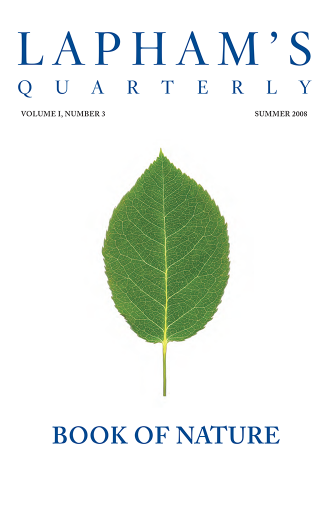What will not attract a man’s stare at sea?—a gull, a turtle, a flying fish!
—Richard Burton, 1883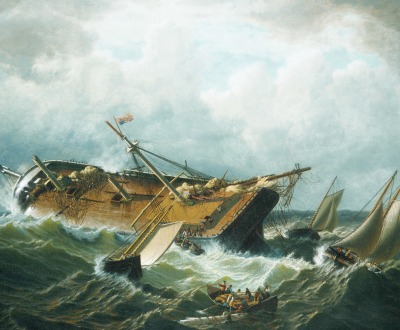
Shipwreck off Nantucket (Wreck off Nantucket after a Storm), by William Bradford, c. 1860-61. The Metropolitan Museum of Art, Purchase, John Osgood and Elizabeth Amis Cameron Blanchard Memorial Fund, Fosburgh Fund Inc. Gift, and Maria DeWitt Jesup Fund, 1971.
I suppose it to be a peculiarly English thing, this intense, near-painful fondness for the ocean that surrounds us. Certainly I had always wanted to be a sailor, and as for many, it was the fine romance of an ocean life that provided the earliest motivation. My preparatory school sat by the sea, and when the nuns took us out for Saturday walks, I liked to stand on the Dorset cliff edges and gaze across the waves toward the lines of great ships far out on the horizon, all of them beating slowly to westward against the wind.
The sisters—though their own familiarity with matters maritime tended to be circumscribed by Noah, his ark, and the length of a cubit—helped anneal the notion with the reading of ocean poetry. There was a lot of John Masefield. I must go down to the seas again, of course, but Quinquireme of Nineveh and Stately Spanish galleon, too, though there on the Channel coast we mostly saw those dirty British coasters with their salt-caked smokestacks, butting into the gales with their cargos of Tyne coal,/Road rails, pig lead,/Firewood, ironware, and cheap tin trays, the final three words we scallywags always yelling out cheerfully in schoolboy unison.
Later there was Rudyard Kipling, who was a little more ominous. He reminded us in particular—for these were still imperial days—how vital was the guarding of our seaways and the protection of the massive, plodding steamers that brought all the necessaries of life to our vulnerable little island. There was rationing still in the England of my youth, and the stanza quoted most frequently at school, pointedly, was the last but one:
"Then what can I do for you, all you big steamers,
Oh what can I do for your comfort and good?"
"Send out your big warships to watch your big waters,
That no one may stop us from bringing you food."
I didn’t want anyone to stop bringing in the food, since there was little enough of it anyway. So perhaps I was destined to command one of Kipling’s big warships, some heavy cruiser with a name like HMS Illustrious or Invincible. In a uniform wreathed in gold braid and with a sleek beast of a warship under my command, I would go off, either to protect the sturdy merchantmen heading for the Western Approaches, or else make way into the open seas through madly violent weather, chance upon some maritime enemy and give him a jolly good biffing, to remind him who—Britannia, naturally—eternally ruled the waves.
For a while my fantasy was encouraged at the boarding school where I spent my teenage years. The staff there insisted we perform military training each week, binding us first to a year of army basics and only then allowing us to join whichever of the three services we preferred—for me it was naturally the naval cadet force. On my very first day in uniform, we found in our local port the USS Missouri, the great American battleship that Admiral Halsey had commanded and on which the Japanese surrender had been signed in Tokyo Bay in September 1945. The admiral, resident on board, invited us on the ship, showed us the sixteen-inch guns that could fire shells the heft of a Volkswagen, and then—a cunning Yankee ploy, I thought—made us holystone his decks for an hour to show us how hard a sailor’s life could be.
But I loved it; and when later we went out for week-long exercises in a pea-sized British frigate called the HMS Grafton, searching for submarines and firing projectiles called “hedgehogs” at them, and when the weather was so bad that our bow was submerged beneath mountains of cold green water, and when the bridge windscreen was shattered by an especially merciless gale, and when even the sailors’ daily rum ration had to be suspended because it was so unsafe below decks, I loved it still more.
I concluded from these ventures that I was just made to be a sailor, a matelot, a sea dog, a jolly Jack tar, to spend my days and years out in the far blue waters. Kipling had promised that we would sail “from Melbourne, Quebec, and Vancouver—/Address us at Hobart, Hong Kong, and Bombay,” and that was precisely what I wanted for myself. With a pretty girl in each place, naturally.
But it was not to be. The dream died suddenly one bleak midwinter afternoon when I was little more than sixteen years old. I had applied for a place at the Britannia Royal Naval College in Dartmouth, and had managed to pass all the necessary tests for entry, except the medical examination. One by one, two by two, my various parts were inspected and found to be in good working order. A single test remained. The doctor took down a ring-bound book from a shelf and opened it to a page with a circle filled containing a mosaic of colored dots. “What number do you see?” he asked with a voice of weary routine.
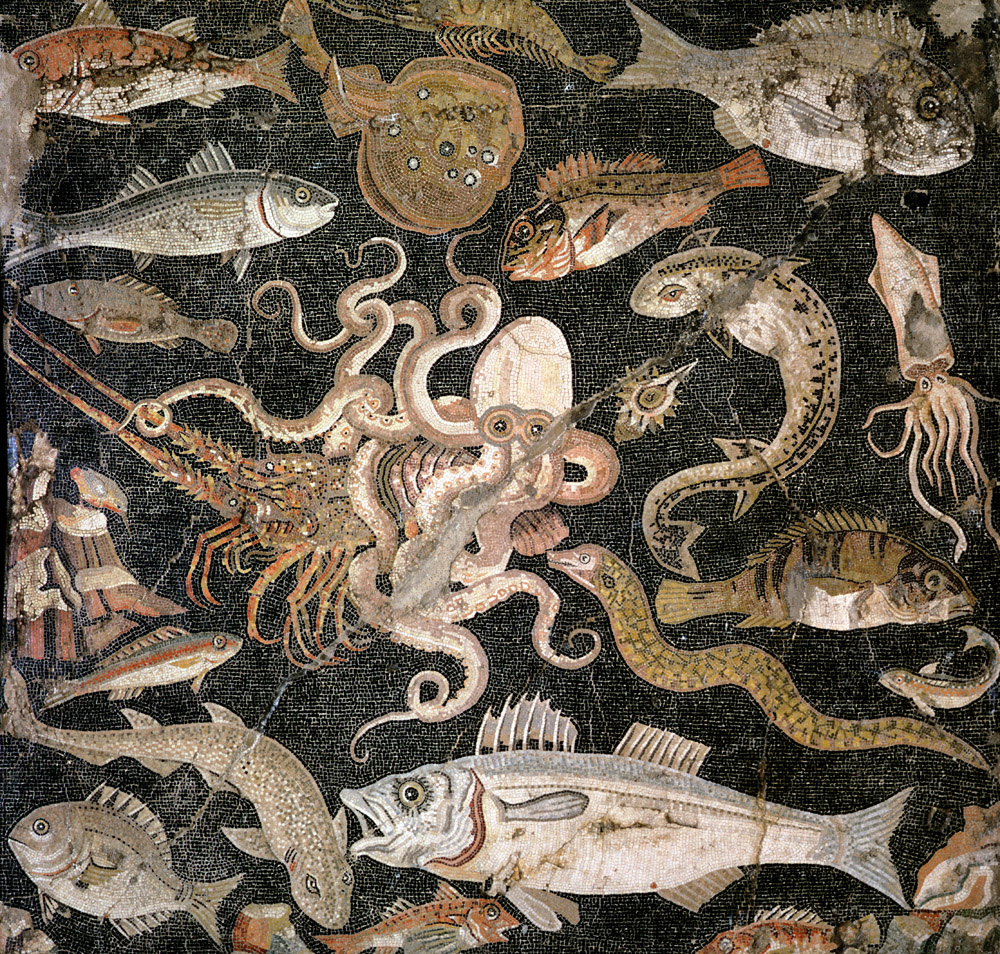
Aquatic life, mosaic, Pompeii, second century BC. Naples National Archaeological Museum.
“Twenty-seven,” I replied.
“Oh dear,” he returned, cocking an eyebrow. He flipped the page to another, very similar circular pattern. “And here?”
“Forty-three,” I said.
He sat up, sighed, then closed his book with an awful finality. He removed his spectacles and leaned toward me. “I regret to have to tell you that Her Majesty takes a somewhat dim view”—he paused here, evidently hoping to lighten the mood before plunging in the dirk—“of young officers trying to drive her extremely expensive warships around the world when they cannot tell red from green, and thus the left from the right. Port from starboard. Your color-blindness, I am sorry to say, ensures you will never join the Royal Navy.”
I stumbled out into the street, wretched with grief, certain my life was over.
That was in 1960. Far from being over, of course, life simply moved in other directions—and at those times when the decision was mine, mostly those directions still involved the sea. A sea which steadily became for me less of an entity bound up in azure-hued romance or brass-bound imperial glory, but which, as I came to know it better, became ever more alarming and mysterious, a creature of terrible puzzlement and power.
A series of small adventures a quarter century later in the Indian Ocean—far from my more familiar Atlantic—entirely altered my youthful convictions. At the time, in pursuit of a mystery whose details do not belong here, I found myself with a lone companion aboard a tiny schooner in the very middle of the ocean, faced with two of the classical problems that customarily afflict the seabound mariner: where exactly was I, and how, precisely, could I get to where I was planning to go? One incident at dawn rendered these problems more than a little pressing.
We knew that at the time we were somewhere south of the Maldives, five hundred miles or so away from the American military base on Diego Garcia, and we had the vague idea we might eventually reach one of the South African ports, perhaps Durban. We had no radio, nor much of a schedule. Drifting through the doldrums, we hoped for a breeze to fill our sails.
We were—or so we thought—miles away from any shipping lanes, and in consequence our seamanship had become slack. Though generally we had taken two-hour turns at watch, our laziness—coupled with the oppressive equatorial heat, the tedious slap of the waves against the hull, the occasional thwack of the sheets against the mast—led to a dangerous dawn ritual: whoever was on watch when the sun rose would set the sails and rudder and then join the other below, both of us sleeping until breakfast time. We told ourselves that the sea was quite empty. There was no danger whatsoever of being run down.
But one morning it happened that we both overslept. It was almost ten when I turned in my bunk, squinted at my watch—and then in terror rushed up to the cockpit. Four hours late, and without a single eye cast over the horizon: to any serious sailor this was quite wantonly irresponsible, beyond foolish. I was at first quite relieved: I stood at the yacht’s starboard side, gazing across at limitless expanse of gray ocean, happy to see that there was not a vessel of any size in sight, anywhere. But then I turned around. And, all of a sudden, on the port side of our boat, there simply was no horizon.
Instead, a huge wall of dark green steel rose high above me, blocking the view entirely. The steel was close enough for me to reach out and touch, which I did. I looked high up toward the sky, and the wall went on and on until there was an overhang, the wing of the great ship’s bridge, and there were men leaning over it, cheering and laughing. We were safe. All was fine, and shipshape.
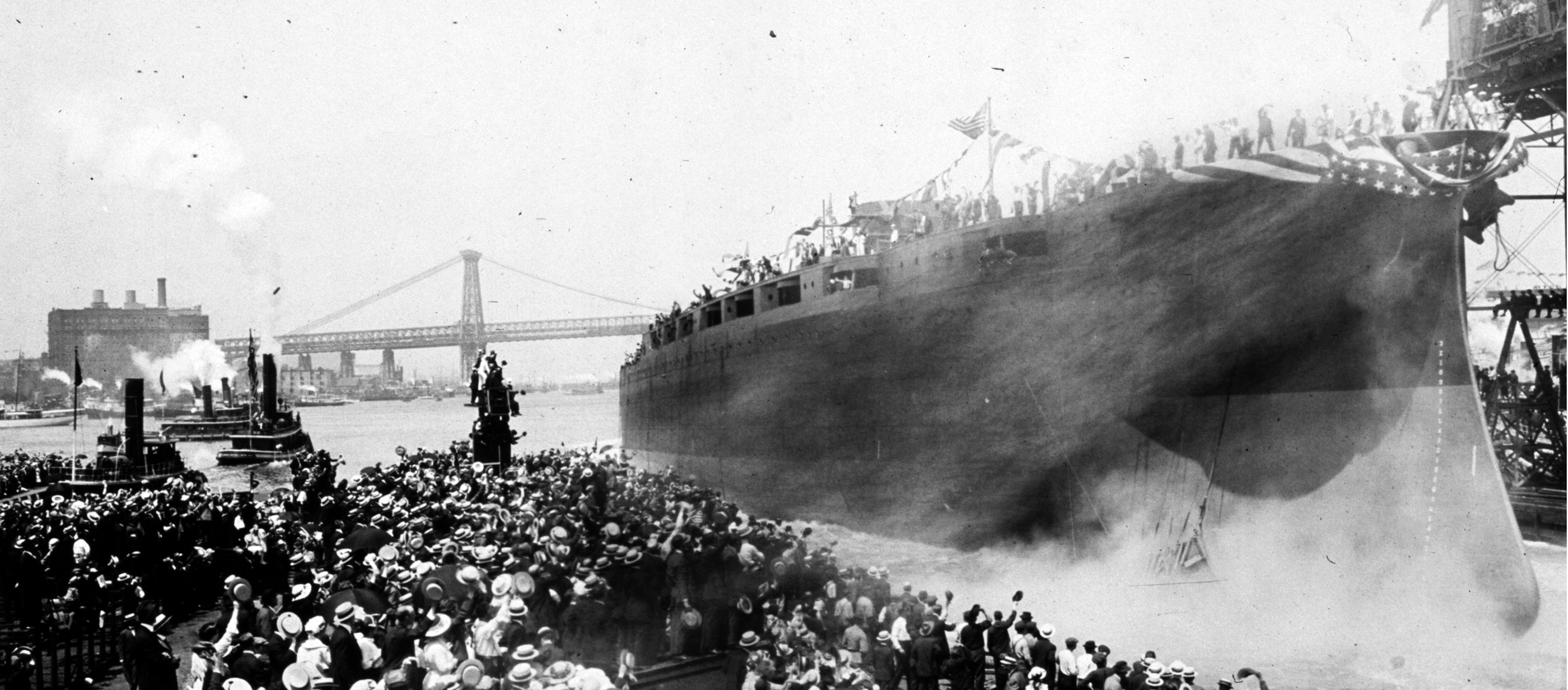
Launching the USS Arizona, Brooklyn Navy Yard, 1915. U.S. National Archives and Records Administration, College Park, Maryland.
But it well might not have been. She was a Japanese car-carrier, on passage between Yokohama and Rio de Janeiro, and she had been plowing a lonely southwesterly furrow across the ocean at a steady twenty knots, when the officer on watch noticed a tiny blip on his radar. He had called out on his VHF radio but heard nothing. He looked through his binoculars, finally seeing a small yacht, its sails flapping uselessly, rolling gently on the swell. There was no one on deck, no sign of humanity. Abandoned, he thought. He gave orders to the helmsman to change course so as to come alongside, then slow to just enough speed to allow for steering-way, and sidle up beside us. On our port side.
He was just preparing to send down a boarding party when he spotted me, newly wakened and now standing with blithe innocence with my back to him, looking out to starboard. He thought for a moment to sound his steam horn but figured I’d have an instant heart attack. He knew I’d be surprised enough when I turned around.
The next fifteen minutes were devoted to the kind of camaraderie you seem only to find out in midocean, where the dangers and risks of the peacetime sea equalize everyone, bend all to a common purpose. They found ropes and lowered to us food and drink (a frozen leg of lamb, bags of strawberries, bottles of Asahi Super Dry), charts (ours had blown overboard some days before) and (for my traveling partner) some kind of shampoo that lathers up in seawater. And then they made preparations to leave. Before spooling up their engines, however, the captain, a stern Japanese officer of some years, leaned over: “Be more careful,” he said, with some solemnity. “Don’t take the sea for granted.”
He then shouted down the coordinates of exactly where we were and signaled that he would push gently away from us, using only a feather touch from his bow thruster. Once there was ten feet of water between our two hulls, we could hear him call down for slow ahead both, and there came a shudder in the sea, and from the stern a huge froth of white water boiled up, and his vessel began to slide away. The white water then began to boil up ever more furiously, the commands grew steadily fainter, the ship—which we could now see whole for the first time—began to shrink away in our field of view until within no more than ten minutes it had quite vanished: there was just a smudge of smoke on the western sky, a steel-flat horizon, and the sea all around us—port, and starboard too, this time—was quite empty once again.
It was then that I vowed to get to know my charts, and to learn how best to navigate. To take the Japanese captain seriously, in other words. My companion was well up to the task—she had already sailed singlehanded all the way up from Australia—and she happily agreed to teach me the rudiments: how to use the sextant, how to sight the sun at noon, how to calculate the hour angle and read the sight-reduction tables, how to tell Betelgeuse from Aldebaran and Rigel and make them work for me, nudging me toward finding my place out here on the high seas.
Seafarers go to sleep in the evening not knowing whether they will find themselves at the bottom of the sea the next morning.
—Jean de Joinville, 1305Once trained, I was to be given no help. She agreed still to stand watches, to make sure I did not put our seven-ton sailing vessel directly in the way of a two-hundred-thousand-ton supertanker. But otherwise she would leave me alone—to find and swing the sun, to calculate and estimate and compute and draw on the charts those lines that began as wide-spaced triangles—the cocked hats of many a midshipman’s early attempts—but which day by day edged closer and closer until they intersected in a neatly drawn point and I could answer with some precision, I hoped, her inevitable question.
Which came after a week of steady westward sailing. Just where are we?
The sea around us on that hot tropic afternoon was empty, once again. It had been so for all of the previous seven days. But now I ventured a suggestion. I said that I believed that at about two a.m. we would see a lighthouse, fine on our port bow. It would flash twice every ten seconds. It would be on the island of Mauritius.
At a little after two in the morning we did indeed spot the flashing light, in the Mauritian capital of Port Louis. And we did open at least one bottle of Dom Perignon for breakfast to celebrate. By using only glass and brass and a series of otherwise incomprehensible numbers, it turned out that I, ingénue extraordinaire, had managed to bring a boat across a thousand miles of trackless sea, and had persuaded it to find its destination with precision of geography and timing, just as a million mariners, from Pytheas and Hanno onward, had done before me. I had become conjoined with the navigators’ community, and colorblind or not, I could now claim, at least on one level, to now know the sea and her ways.
And for many years following, this is what I fully believed. I would wander ceaselessly about on the world’s oceans, in a variety of boats, in all weathers and seasons and climates. I sailed the Drake Passage in a vicious August gale. I passed south through the Sunda Strait, with ash from Anak Krakatau raining down on our craft. I slunk north through the Bering Strait in an icebreaker, dodging bergs under a blanket of thick fog. I went twice on passage to Pitcairn Island in the middle of the Pacific nowhere, and managed almost to founder our boat in search of whirlpools south of the Lofoten islands, off Norway.
Every sea, every year, every season, every latitude. And yet steadily, as I wandered ever more distantly, the inevitable happened. The early conceit of knowledge began to fade; new, unimagined mysteries began to scrape away the veneers on the surfaces of received truths, and over the years I slowly came to an entirely new acceptance—one that I now know is common to all who are properly fascinated by and respectful of the sea: that what we know of her, in truth, is just about nothing. To think otherwise is truly quite preposterous.
Ignorance—or more kindly put, a profound unfamiliarity—has long dogged mankind’s relationship with the sea. It was widely held misapprehensions about the Atlantic, though not the first great ocean to be crossed (the Indian Ocean wins that distinction), that posed most of the challenges to early would-be mariners. Those who first poked the prows of their tiny wooden boats beyond the Pillars of Hercules entertained countless false assumptions about the storm-tossed waters beyond. The seas writhed with monsters—gigantic sea goats, Gorgons, Hecatoncheires—and were dotted with mythical islands and sea kingdoms—Atlantis most notably; but also eventually Frisland, Antillia, St. Brandan and Hy-Brasil—into which ships might collide and where sailors might be wolfed down by terrifying inhabitants.
It’s My Island I, by Antti Laitinen, 2007. C-print, Diasec, edition 6, 115 x 115 cm. © Antti Laitinen, courtesy the artist and Galerie Anhava, Helsinki.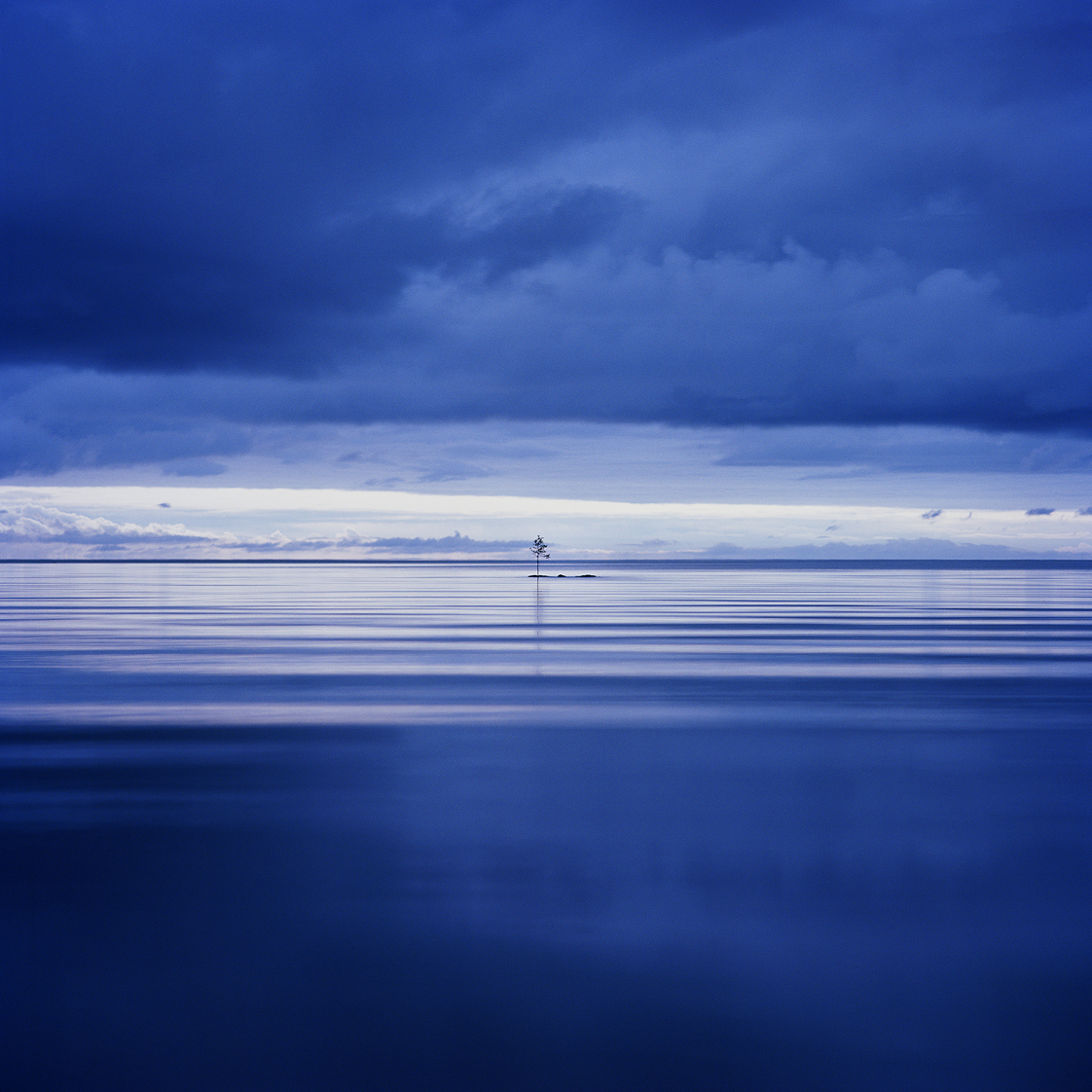
Such lunatic imaginings finally lifted once the oceans’ surfaces had been crossed and charted, but then strange beliefs about what lay in the deeps tended to take over. In Victorian times there was a persistent belief, for instance, that seawater became denser the deeper down in it you went, so much so that layers of more viscous deep water prevented some objects from sinking below a certain level. Pieces from a wrecked iron ship could only descend to a fixed point in the sea and then hover there for eternity, never hitting bottom. A dead person would sink to a depth dependent upon his girth, his clothing, and (according to some of the maritime priesthood) the accumulated burden of his sins.
These particular beliefs, held largely of course by the nonscientific, nonetheless had also something of an irritant effect on science itself. Even as well-regarded a Victorian paleontologist as T. H. Huxley—“Darwin’s bulldog”—was not immune from folly. Huxley once discovered, in samples given to him by the survey ship HMS Cyclops, a jellylike ooze that had been brought up by a deep-sea dredge. He became instantly overexcited by the find. In its gelatinous quiverings he imagined he saw life as it once must have been, promptly declared it to be a primordial sludge that must carpet the entire seabed and be the fons et origo of all marine living creatures, and christened it Bathybius haeckelii, in honor of a German colleague, Ernst Haeckel, who had coined the word ecology.
For seven years his discovery remained on the books, with Huxley’s reputation helping to keep it so, despite no other discovery to corroborate his own. But then a humble chemist, working alone and with only a basic set of reagents, decided to look more closely at Bathybius. Almost immediately he discovered that the slime was not in fact any kind of life form, nor anything resembling it. It was simply a chemical reaction between seawater and preserving alcohol, a reaction that had created flocculation in the test tube, and a sudden precipitation of flakes and particles that shouldn’t have been there in the first place. To his credit, Huxley, with a public expression of mordant dignity, took full responsibility. And to the amusement of the biological community, he renamed the creature that never was Blunderibus, and didn’t speak of it again.
He who commands the sea has command of everything.
—Francis Bacon, 1600All scientists who come upon such things continue to draw a lesson from poor Dr. Huxley’s experience. One marine biologist from MIT named Penny Chisholm did so most particularly in 1988, after coming across something quite unanticipated while bobbing quietly on the Sargasso Sea on a boat called RV Oceanus. Along with fellow researchers, she discovered, drifting just barely beneath the water’s surface, what is arguably the most numerous, quite possibly the most important, and certainly one of the most unpronounceably named creatures on the planet.
Running seawater through something called a flow cytometer—a device more commonly used to detect cellular abnormalities in human blood—Chisholm came across an unfamiliar single-cell bacterium. The existence of this new creature, which she continued to see again and again, seemed incontrovertible.
But before revealing her find to the rest of the world, there were weeks and months of soul-searching—for was it truly real? Could it be a laboratory artifact? A Huxley-like reaction? And, most importantly—why had it not been discovered before? “It’s hard to believe,” remarked one oceanographer at Duke University, “we’d overlooked something so important for so long.” Through it all Dr. Chisholm stuck to her guns, and her belief, and eventually gave her remarkable find a name—Prochlorococcus.
Like our planet’s trees, Dr. Chisholm’s bacterium—a sausage-shaped creature that is little more than half a micron in diameter—obtains its life force through the marvels of photosynthesis: it absorbs carbon dioxide, and employing as its agent such sunlight as is visible in the upper region of all the seas, it regurgitates the gas as oxygen. It produces so much oxygen that in fact one in every five breaths we take is likely produced by this tiny, single-celled oceanic creature—a creature that we only learned about twenty-five years ago.
This simple fact is then augmented by another—though more properly a supposition—that is both subtler and more uncertain. Since the beast likes to live in warm water (draw a line between New Jersey and Gibraltar and another between Buenos Aires and Cape Town, and you have the approximate northern and southern boundaries of its home) it will probably increase in both its range and numbers as the world’s seas continue to warm. And since this warming is said to be the result of greater levels of man-made carbon dioxide in the world’s atmosphere, and since Prochlorococcus absorbs this gas—then the more of them there are in the ever warmer seas, so the more noxious gases will be absorbed and the more oxygen sent back into the atmosphere, until the balance is restored. This is the Gaia hypothesis of the world as a self-regulating entity in practice, in action. Providing, that is, that humankind regulates and reduces the amount of emitted greenhouse gases to a more sensible and manageable norm.
That such a beast was not found until 1988—and to reiterate: it is presumably the most numerous creature on the surface of the earth; there are 100 million in a quart of seawater; the population can be counted in the trillions upon trillions—and that it was then discovered drifting blithely in the upper shallows of the sea, hardly hidden at all, is surely proof that the ocean that we think we know is more unknown in fact than we will ever realize. The ocean that is this creature’s home, and is home to a myriad things, living and not, of which we still understand so little, or nothing, is not merely a thing of power and danger and vastness: it is a place of profound unknowingness, with shallows unplumbed and depths probably unplumbable, for eons yet to come.
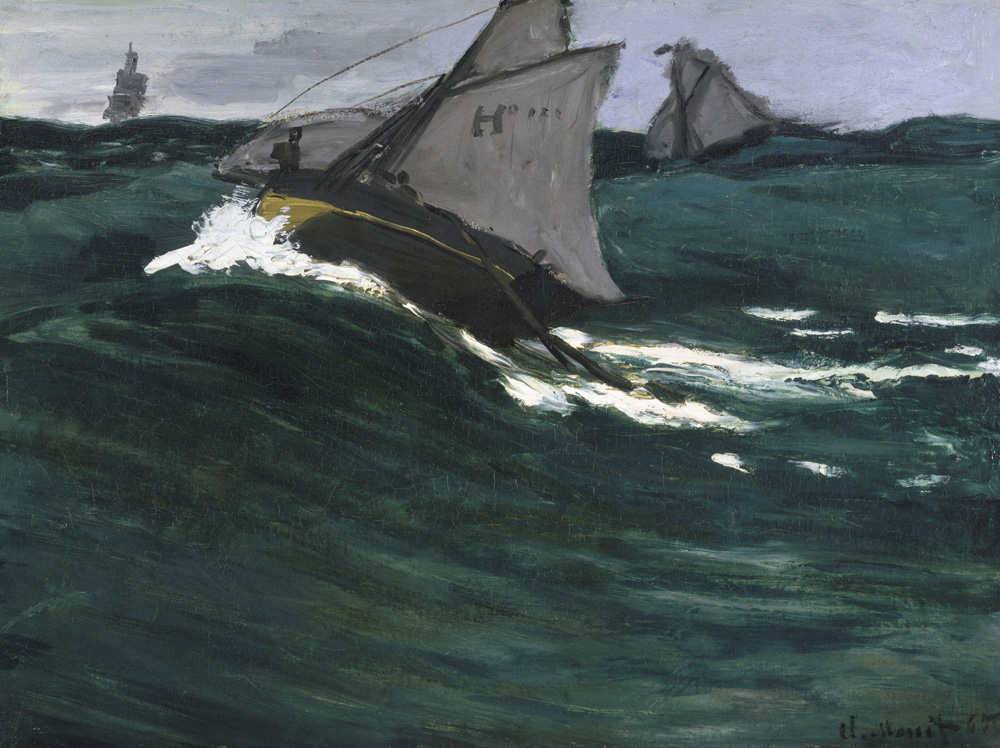
The Green Wave, by Claude Monet, c. 1865. The Metropolitan Museum of Art, H. O. Havemeyer Collection, Bequest of Mrs. H. O. Havemeyer.
What of the uncounted ships that lie down there in the dark, unseeable relics of battles long ago lost and voyages long ago interrupted? What of the great trenches and chasms, like the Challenger Deep, the Mindanao, the Kermadec, and their canyon kin, so many miles deep that they could swallow entire Himalayan ranges and barely notice—what of the mysteries so far down in abysses such as these? Once in a while illuminations of their benthic scenery are revealed by the tiny armored vehicles which make forays into these forbidding frontiers suspended on stout wires. But then they scurry back up into the blue waters and leave the great deeps dark and cold, profoundly unknown still, and likely to remain so for years still come.
As a small boy I once just loved the sea; I then came to fear it and revere it; and for a brief few months and years—after my small navigational triumph in the Indian Ocean doldrums—I thought I had come to know it. But that was all fantasy—for as the small creature of the Sargasso so adroitly reminds us—we know less about the seas today than we know about the surfaces of Mars, or of the moon. The water covers all in a shroud of mystery. And love the oceans though we might and fear them though we should, to know their waters truly will simply not be possible until, as Robert Burns put it so long ago, “the seas gang dry, my dear,/and the rocks melt wi’ the sun.”




